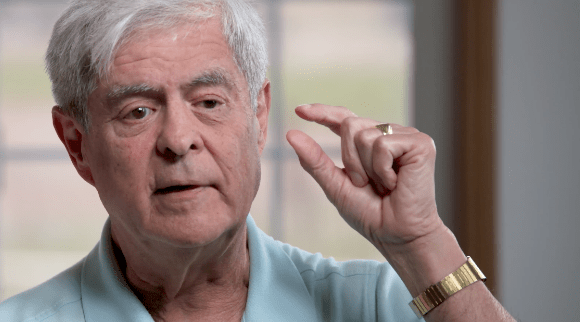Ron and Vicki Transcript
Ron:
I’m Ron. I have Graves’ disease and Thyroid Eye Disease. I was in law enforcement for 33 years, and simultaneously in the military reserves for 27.
Vickie:
We’ve been married for 28 years. We were both in the Coast Guard reserves.
Ron:
As a police officer, I periodically would have some blurred vision. Little bit of dizziness. One day I looked in the mirror, my right eye was completely as far as it would go toward my nose and looking upward. I was horrified. I was panicked. I didn’t know what it meant.
Vickie:
So I said we do need to go get this checked out because obviously something is wrong.
Ron:
The bulging and movement of the eyeballs was compressing my optic nerves. There was some question as to whether I would go completely blind. Not a lot of people knew what was happening initially. Then ultimately an endocrinologist said, “Yes, I know what’s wrong with you.”
Text on screen:
After months of increasing symptoms and loss of eye function, Ron was finally diagnosed with both Graves’ disease and thyroid eye disease.
With Ron’s vision rapidly deteriorating, doctors decided they needed to act fast.
Ron:
To save my vision, and prevent me from going completely blind, they had to perform fairly immediate surgery. And they did the first of six surgeries. Living with Thyroid Eye Disease certainly has its challenges. I had to rely on Vickie either to get me to and from work, or to get me to the bus stop.
Vickie:
My take charge husband having to rely on me and other people when that was not in his personality, which increased his frustration.
Ron:
I was not allowed on a public bus one time because I couldn’t read the destination above the driver’s windshield. And I asked him, “Does this bus go to so-and-so?” And he said, “Read the, the thing!” And I said, “I can’t!” And he says, “Well, then get off the bus!” I said, “I can’t read it because I’m legally blind.” Which I was. There was no bus ride for me that day. My blurred vision and such deteriorated to the extent I knew I could not perform on patrol duty. The Chief and the Captain had me turn over my weapon, and suddenly I can no longer do the things that cops do.
Text on screen:
Today, more than two decades since Ron’s diagnosis, they push forward with strength and gratitude.
Ron:
There are days when my eyes will start to cross or wander around and I’ll have dizziness and blurred vision, but I absolutely refuse to be a victim. For anyone who is suddenly having an onset of blurred vision, please don’t wait, don’t take chances, contact an endocrinologist and an ophthalmologist. Both of whom are experience with Thyroid Eye Disease and Graves’.
Vickie:
And I would add, that even if you don’t know that those are symptoms of Graves’ or the onset of Thyroid Eye Disease, if you are having symptoms that are significant—and double vision is definitely a significant symptom of something—don’t just pass it off as “I’m tired.”
Ron:
Vickie has meant everything to me. All is not lost, it’s just the beginning of a journey that can still be a pretty good journey.
Vickie:
We just don’t let any of the good days or bad days stop us from doing anything.








